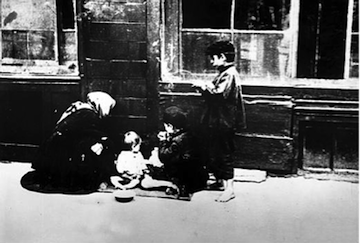

|
The Perpetrators  Kulak family living on the streets The men and women who carried out this brutal war against the peasantry were mostly soldiers and workers. Hatred of the 'kulak parasites' had been drummed into them. 'We were trained to see the kulaks, not as human beings, but as vermin, lice, which had to be destroyed', recalled the leader of a Komsomol brigade in the Kuban. Others were enthusiasts and fanatics, inspired by the messianic hopes of the Five Year Plan, who thought they were creating a Communist society and believed the end justified the means. Lev Kopelev, a young Communist who took part in some of the worst atrocities against the Ukrainian peasants, was appalled by the children's screams, but he told himself not to 'give in to debilitating pity. We were realizing historical necessity. We were performing our revolutionary duty. We were obtaining grain for the socialist fatherland. For the Five Year Plan.' There was widespread peasant resistance to collectivization: 44,779 'serious disturbances' were registered by the police in 1929-30. It was almost a return to the situation at the end of the Civil War, when peasant uprisings had forced the Bolsheviks to introduce the NEP, only this time round the Soviet regime was strong enough to crush the peasant resistance. Realizing their own impotence, the peasantry adopted the traditional 'weapons of the weak' to sabotage collectivization: they slaughtered their own livestock to prevent them being requisitioned by the kolkhoz. The number of cattle in the Soviet Union fell by half from 1928 to 1933. Faced with the ruin of the agricultural sector, Stalin called for a temporary halt to the collectivization campaign. In an article in Pravda ('Dizzy with Success') on 2 March 1930, he accused local officials of excessive zeal in setting up kolkhozes by decree. Millions of peasants saw this as a license to leave the collectives, and they voted with their feet. The population of the collective farms fell from from 58 to 24 per cent of peasant households between March and June. But in September Stalin launched a second offensive with the aim to collectivize at least 80 per cent of the peasantry by the end of 1931. OGPU prepared a thousand 'special settlements', each to receive up to 300 'kulak' families, in the North, the Urals and Kazakhstan. Two million people were exiled to these remote regions in 1930-31. The destruction of the 'kulaks' was a catastrophe for the Soviet economy. It deprived the collective farms of the best and hardest working peasants, ultimately leading to the terminal decline of the Soviet agricultural sector. But Stalin's war against the 'kulaks' had little to do with economic consideration - and everything to do with the removal of the defenders of the old rural way of life. Collectivization had a deeper impact on the rural population than the events of 1917 and the Civil War. It meant the end of the ancient peasant commune and millions of family household farms; the end of the village with its church as the centre of the peasant way of life. I recommend these two short documentaries on collectivization and its disastrous consequences. |
© 2014 Orlando Figes | All Rights Reserved